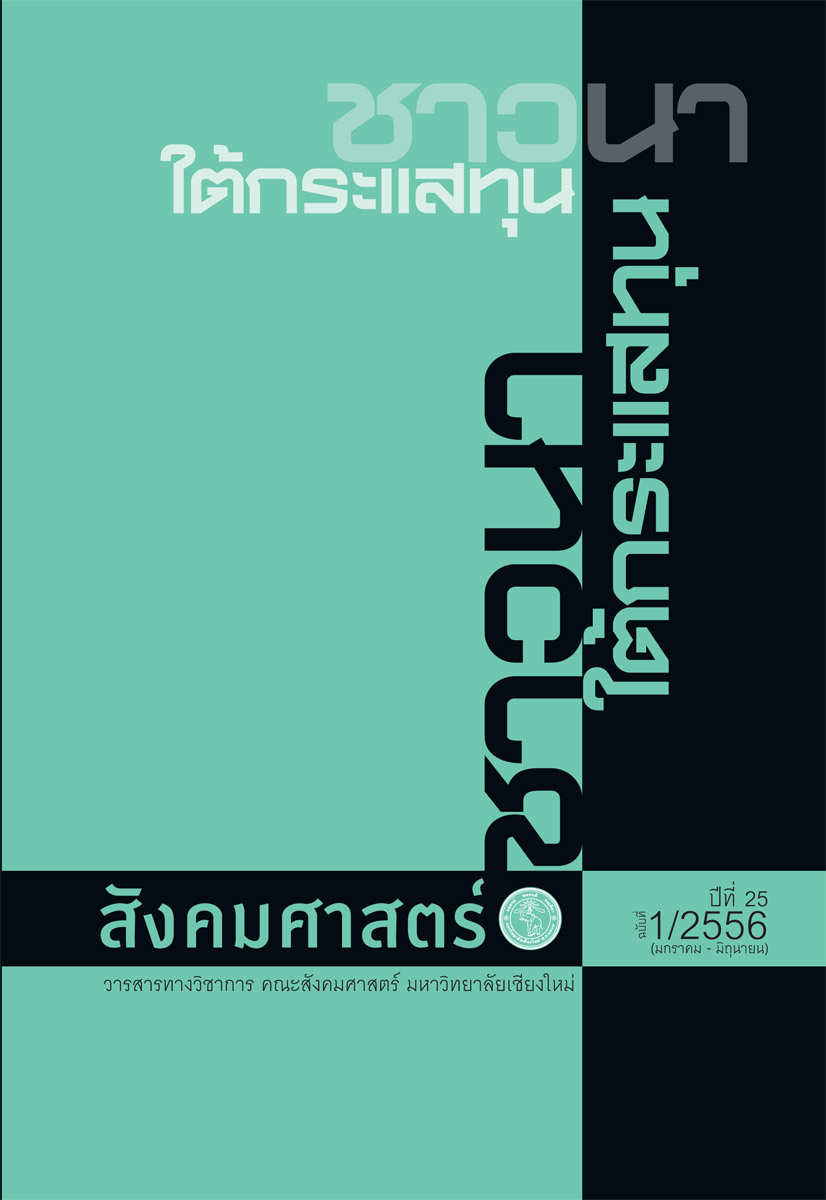Rubber Plantation and Livelihood Transformation in Northern Thai Communities
Main Article Content
Abstract
Increasing large-scale and small-scale rubber plantation and its economy has been expanding in Northern Thailand, particularly after 2000. This paper is to study the expansion of rubber economy and its impact on the change in agricultural landscape from paddy and hill-rice field, cash crop and fruit orchards into rubber landscape. The paper proposes that rubber expansion has created both negative and positive impacts on local communities of Northern Thailand in 3 dimensions, both in short term and long term; namely in economic, socio-cultural, and environmental dimensions.
Article Details
All written articles published on Journal of Social Sciences is its author’s opinion which is not belonged to Faculty of Social Sciences, Chiang Mai University or is not in a responsibility of the journal’s editorial committee’s members.
References
ฉกรรจ์ แสงรักษาวงศ์. 2544. แนวคิดการพัฒนาแผนยุทธศาสตร์การพัฒนายาง.เอกสารประกอบรายงานการสัมมนายางพาราแห่งประเทศไทย ครั้งที่ 4 เรื่อง “พัฒนายางพาราไทย กู้ภัยเศรษฐกิจ” 17-20 กันยายน 2544 ณ โรงแรม เจ บี อำเภอหาดใหญ่ จังหวัดสงขลา.
นฤเทพ บุญเรืองขาว. 2550. การติดตามตรวจสอบประเด็นปัญหาสิ่งแวดล้อมจากอุตสาหกรรมยางพาราในเขตภาคใต้ตอนล่าง. วิทยานิพนธ์ มหาวิทยาลัยสงขลานครินทร์.
ปราโมทย์ แก้ววงศ์ศรี. 2554. รูปแบบการปลูกยางพาราในปัจจุบันและผลกระทบต่อความหลากหลายทางชีวภาพ. สงขลา : คณะทรัพยากรธรรมชาติ มหาวิทยาลัยสงขลานครินทร์.
พงษ์ศักดิ์ วิทวัสชุติกุล และพิณทิพย์ ธิติโรจนะวัฒน์. 2553. ทำไมจึงไม่ควรปลูกยางพารา
บนพื้นที่ต้นน้ำ. เอกสารเผยแพร่ที่ 3/2553. กรุงเทพฯ : ส่วนวิจัยต้นน้ำสำนักอนุรักษ์และจัดการต้นน้ำ กรมอุทยานแห่งชาติ สัตว์ป่า และพันธุ์พืช.
ยศ สันตสมบัติ. 2544. ความหลากหลายทางชีวภาพและภูมิปัญญาท้องถิ่นเพื่อการพัฒนาอย่างยั่งยืน. คณะสังคมศาสตร์ มหาวิทยาลัยเชียงใหม่.
ยศ สันตสมบัติ และอรัญญา ศิริผล. 2555. จากป่าใช้สอยสู่สวนป่าขนาดใหญ่ :การศึกษาเปรียบเทียบผลกระทบของการลดลงของความหลากหลายทางชีวภาพต่อภูมิปัญญาท้องถิ่นความมั่นคงทางอาหาร และการปรับตัวของชุมชนท้องถิ่นในเขมร ลาว และไทย. รายงานการวิจัยฉบับสมบูรณ์ สนับสนุนโดยโครงการพัฒนาองค์ความรู้และศึกษานโยบายการจัดการทรัพยากรชีวภาพในประเทศไทย
(Biodiversity Research and Training Program-BRT).
ศักรินทร์ ณ น่าน. 2551. การแพร่กระจายของยางพาราในเขตภาคเหนือตอนบนของประเทศไทย . หน่วยวิจัยสังคมและสิ่งแวดล้อม คณะสังคมศาสตร์ มหาวิทยาลัย
เชียงใหม่.
สำนักงานกองทุนสงเคราะห์การทำสวนยาง. 2548. บอกกล่าว...เล่าขานตำนาน สกย. กรุงเทพฯ : สำนักงานกองทุนสงเคราะห์การทำสวนยาง.
สำนักงานเศรษฐกิจการเกษตร. 2550. ยางพารา : เนื้อที่ยืนต้น เนื้อที่กรีดได้ ผลผลิต
และผลผลิตต่อไร่ ปี 2548-2549 รายจังหวัด. กระทรวงเกษตรและสหกรณ์.
อรัญญา ศิริผล. 2554. สวนยางพารากับกระบวนการปรับเปลี่ยนวิถีชีวิตทางเศรษฐกิจสังคมของชุมชนท้องถิ่นภาคเหนือตอนบน. รายงานฉบับสมบูรณ์ ได้รับทุน
สนับสนุนการวิจัยจากทุนพัฒนานักวิจัยรุ่นใหม่ มหาวิทยาลัยเชียงใหม่.
ภาษาอังกฤษ
Aranya Siriphon. 2011. “Competing to Lead : a case study of Chinese-Thai Venture on Rubber Industries in Northern Thai Border”. A paper presented at Workshop Theme : “Foreign Aid, Land Concession and Territorialization. March 31-April 3, Venue : Army Hotel, Hanoi Vietnam.
Dijkman, M. 1951. Hevea-Thirty Years of Research in the Far East. Univ Miami
Press, Coral Gables, Florida, USA.
Jamaree Pitackwong. 1996. Disorganized Development : Changing Forms of Work and Livelihood in Rural Northern Thailand. PhD. Thesis School of Oriental and African Studies, University of London.
Li, Hongmei, T. Mitchell Aide, Youxin Ma, Wenjun Liu and Min Cao. 2007. “Demand for rubberis causing the loss of high diversity rain forest in SW China”, In Biodiversity and Conservation 16, pp. 1731-1745.
Long, Norman. 1984. “A Perspective on the Sociology of Development”. In Sociologia Ruralis Vol. 24, Issue 3-4, pp. 68-184.
Liu, Wenjun. 2006. “Environmental and Socio-economic Impacts of Increasing Rubber Plantation in Menglun Township, Southwest China”. Mountain Research and Development Vol. 26 (3), pp. 245-253.
Lang, Chris. 2004. “Plantations are not Forests-Even when certified by the Forest
Stewardship Council”. Watershed Vol.9 No.3 March-June 2004 : 44-46.
Lee, Elsa W.S., Billy C.H. Hau and Richard T. Corlett. 2005. “Natural regeneration
in exotic tree plantations in Hong Kong, China”. For Ecol. Manage 212 :358-366.
O’Brien, N. (ed.). 1999. Environment : concepts and issues-a focus on Cambodia.
UNDP/ETAP Reference Guidebook. Phnom Penh, Government of Cambodia,
Ministry of Environment.
Rigg, Jonathan. 2001. More than a Soil : Rural Change in Southeast Asia. Harlow :
Prentice Hall.
Zhuang, X.Y. 1997. “Rehabilitation and development of forest on degraded
hills of Hong Kong”. Forest Ecology and Management. 99 : 197-201


